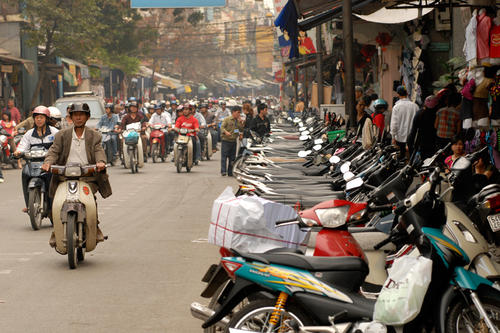For Short Distances and Clean Air
Researchers study Hanoi to identify solutions to gridlock
May 07, 2014
Gridlock during rush hour: Thousands of Hanoi residents drive through the city. An app developed by German and Vietnamese researchers aims to provide some relief.
Image Credit: guenterguni-iStockphoto
It is a cloudy evening in Hanoi. The air is clammy, cool, and humid. Night is falling, and people want to get home. They have put on their facemasks and donned brightly colored helmets. On scooters by the thousand, they sputter along past the shops of the city’s historic center and sidewalk food vendors.
They are packed together, with only an occasional bicycle weaving its way through the machines. Cars don’t stand a chance. It’s rush hour in the Vietnamese capital, and walking is often faster than moving on two wheels.
“Traffic jams cost the economy a huge amount of money, plus they damage the environment and harm people’s health,” says Hans-Peter Thamm, of the Institute of Geographical Sciences at Freie Universität Berlin. To help prevent these kinds of traffic jams in Hanoi in the future, Thamm, who holds a doctorate in Earth sciences, is working with partners from Vietnam and Germany in the REMON (Real Time Monitoring of Urban Transport – Solutions for Traffic Management and Urban Development in Hanoi) project. Their goal is to develop a GPS-based traffic information system to help motorcycles, mopeds, scooters, and cars in the Vietnamese capital get from point A to point B faster not long from now.
Under the leadership of Matias Ruiz Lorbacher, who holds a Diplom degree in geography, the project coordination is being handled by INA GmbH, a nonprofit organization at Freie Universität Berlin that goes by the title “International Academy of Innovative Pedagogy, Psychology, and Economics.”
“On behalf of the German Federal Ministry of Education and Research, we will work with our partners in Germany and Vietnam to develop solutions for how carbon dioxide emissions can be reduced in emerging economic areas as part of the REMON project,” Thamm says.
The idea the researchers hope to use to get the nerve-racking traffic jams under control is as simple as it is ingenious. “We hope to provide road users in Hanoi with a smartphone app that collects data on the traffic situation, giving drivers a view of the big picture in real time,” he explains.
The compact program, developed by Berlin-based software company LUAX in cooperation with the German Aerospace Center (DLR), should be ready for use later this month. At that point, the plan is for tens of thousands of users to make a comprehensive real-world test possible. “But we only get one try,” Thamm cautions. “Cell phone users won’t put up with errors. They’ll quickly delete the program if it doesn’t work reliably,” he says.
The most important local partners, aside from official bodies such as the office of urban planning, are the taxi companies in the Vietnamese capital. They have a stake of their own in receiving current traffic information, since it will let them deploy their taxi fleets more efficiently.
The REMON researchers have also received raw data this way that could help make using the city’s existing infrastructure more efficient. Thamm says, “After we analyze and chart the data, we can quickly see where inefficient switching of traffic signals or construction sites impede the flow of traffic in the city.”
Where are people going, and what routes do they take to get there? How is economic growth changing the city? And what are some possible approaches to keep distances short? The researchers are looking for answers to these and other questions.
Another partner in the project, the architecture firm of Albert Speer und Partner GmbH (AS&P), plans to develop model urban planning concepts in the medium term that largely avoid long distances and motorized traffic. “Right now, the population of Hanoi is growing by about 200,000 to 300,000 people a year – and the number of new buildings is extreme,” Thamm says. This means the available map material is often too inaccurate.” With this in mind, the team is relying on high-resolution satellite images and developing a model of the city’s growth to chart the dynamics of settlement in the area. “From a Central European perspective, you simply can’t imagine how fast whole neighborhoods spring up in Vietnam. It happens practically overnight,” he explains.
The project is scheduled to receive a total of about 2.3 million euros in funding from the German federal government from now until 2015. About 390,000 euros of that amount is earmarked for the work being done by the researchers at Freie Universität.
The spending is well worthwhile, Thamm says with conviction. “Our goal is to help make sure cities with a decent quality of life arise in emerging economies, while also making certain they don’t repeat every mistake made by urban planners in the industrial centers of the Western world over the past century.” The ultimate aim: To keep traffic flowing during rush hour, even in Hanoi, and ensure that people don’t need to wear facemasks.
Further Information
- Dr. Hans-Peter Thamm, Institute of Geographical Sciences, Freie Universität Berlin, Tel.: +49 30 838 70 342, Email: hpthamm@zedat.fu-berlin.de
- Homepage: http://www.remon-hanoi.net/

